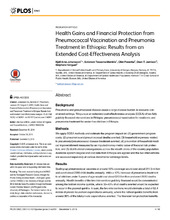| dc.contributor.author | Johansson, Kjell Arne | en_US |
| dc.contributor.author | Memirie, Solomon Tessema | en_US |
| dc.contributor.author | Pecenka, Clint | en_US |
| dc.contributor.author | Jamison, Dean T. | en_US |
| dc.contributor.author | Verguet, Stéphane | en_US |
| dc.date.accessioned | 2016-12-16T09:37:07Z | |
| dc.date.available | 2016-12-16T09:37:07Z | |
| dc.date.issued | 2015-12-09 | |
| dc.Published | PLoS ONE 2015, 10(12):e0142691 | eng |
| dc.identifier.issn | 1932-6203 | |
| dc.identifier.uri | https://hdl.handle.net/1956/15246 | |
| dc.description.abstract | Background: Pneumonia and pneumococcal disease cause a large disease burden in resource-constrained settings. We pursue an extended cost-effectiveness analysis (ECEA) of two fully publicly financed interventions in Ethiopia: pneumococcal vaccination for newborns and pneumonia treatment for under-five children in Ethiopia. Methods: We apply ECEA methods and estimate the program impact on: (1) government program costs; (2) pneumonia and pneumococcal deaths averted; (3) household expenses related to pneumonia/pneumococcal disease treatment averted; (4) prevention of household medical impoverishment measured by an imputed money-metric value of financial risk protection; and (5) distributional consequences across the wealth strata of the country population. Available epidemiological and cost data from Ethiopia are applied and the two interventions are assessed separately at various incremental coverage levels. Results: Scaling-up pneumococcal vaccines at around 40% coverage would cost about USD 11.5 million and avert about 2090 child deaths annually, while a 10% increase of pneumonia treatment to all children under 5 years of age would cost about USD 13.9 million and avert 2610 deaths annually. Health benefits of the two interventions publicly financed would be concentrated among the bottom income quintile, where 30–40% of all deaths averted would be expected to occur in the poorest quintile. In sum, the two interventions would eliminate a total of USD 2.4 million of private household expenditures annually, where the richest quintile benefits from around 30% of the total private expenditures averted. The financial risk protection benefits would be largely concentrated among the bottom income quintile. The results are most sensitive to variations in vaccine price, population size, number of deaths due to pneumonia, efficacy of interventions and out-of-pocket copayment share. Conclusions: Vaccine and treatment interventions for children, as shown with the illustrative examples of pneumococcal vaccine and pneumonia treatment, can bring large health and financial benefits to households in Ethiopia, most particularly among the poorest socio-economic groups. | en_US |
| dc.language.iso | eng | eng |
| dc.publisher | PLOS | eng |
| dc.rights | Attribution CC BY | eng |
| dc.rights.uri | http://creativecommons.org/licenses/by/4.0 | eng |
| dc.title | Health gains and financial protection from pneumococcal vaccination and pneumonia treatment in Ethiopia: results from an extended cost-effectiveness analysis | en_US |
| dc.type | Peer reviewed | |
| dc.type | Journal article | |
| dc.date.updated | 2016-11-04T09:16:41Z | |
| dc.description.version | publishedVersion | en_US |
| dc.rights.holder | Copyright 2015 The Author(s) | |
| dc.identifier.doi | https://doi.org/10.1371/journal.pone.0142691 | |
| dc.identifier.cristin | 1342098 | |

